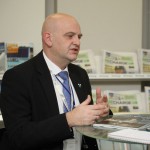Linking up the north
 One of the biggest grids-related buzzes in the last couple of years has been the coming together of ten countries to promote an interconnected power network in the northern European seas. At the GRIDS 2010 event in Berlin I caught up with Jan Hensmans from Belgium’s Economy Ministry, who explained the ‘North Seas Countries Offshore Grid Initiative’ (NSCOGI) in more detail.
One of the biggest grids-related buzzes in the last couple of years has been the coming together of ten countries to promote an interconnected power network in the northern European seas. At the GRIDS 2010 event in Berlin I caught up with Jan Hensmans from Belgium’s Economy Ministry, who explained the ‘North Seas Countries Offshore Grid Initiative’ (NSCOGI) in more detail.
Why did Belgium decide to get involved in NSCOGI?
We saw the huge energy potential of the north seas and we had been involved in the ‘pentalateral energy forum’ with Germany, France, the Netherlands and Luxembourg, but five countries were not enough! So we set up a meeting with those and additional countries and the ministers signed a political statement on 7 December 2009. Then we organised a high level meeting in Ostend with EWEA – at which we agreed to sign a memorandum of understanding, which we will do on 3 December in Brussels.
What will the MoU cover, and who exactly will sign?
The MoU is a political vision of where we want to go in terms of connecting and extending the grid, and how we see the future energy mix. The vision will cover four main areas – grid configuration, market issues, regulatory issues and planning and authorisation procedures.
NSCOGI is driven by governments and the ministers will sign it, along with ENTSO-E (the European transmissions system operators), and ACER (the European energy regulators), with whom we have close contacts.
What are the next steps?
We are currently filling in a database of what is currently being done related to the initiative and who is doing it, and what still needs to be done by whom. As of next year we will have working groups and we would like to get most of the start-up work done by the end of 2011. We are also thinking how we can get other stakeholders – such as consumers and NGOs – involved in the process. Long-term, we are looking to 2020 and beyond, to 2030.






